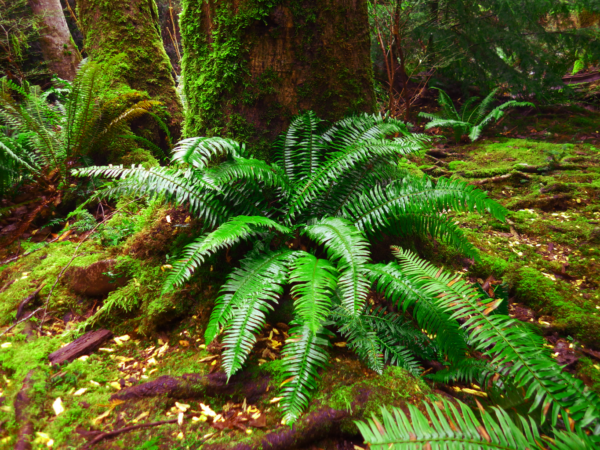Plant Life: Western Sword Fern
There are a number of native plants that may be taken for granted in a Pacific Northwest garden. This is not because they are uninteresting or dull, but likely just because they are so common that we tune them out like botanical white noise that is the filler around the more eye-catching species. But even filler plants have a story and are interesting in their own right.
One of the most common understory plants in Western Washington is the Western Sword Fern (Polystichum munitum). Both local gardeners and students of Western Washington botany are sure to be familiar with this iconic, native plant species. You will see the Western Sword Fern in shaded, low to mid-level elevations of forested land all around the Sound. And Bloedel Reserve is no exception. If it is not the most common species of fern at the Reserve, it is easily in the top five.
A Fern with an Edge
 The Sword Fern’s evergreen fronds make it easy to identify. They are “once-pinnate,” which in fern terminology means each frond has one central stem with leaflets (or “pinnae”) branching off left and right. Deer Fern and Licorice Fern, both evergreen and common at Bloedel, also fit this description. But Sword Fern leaflets are edged by tiny pointed teeth, while the other two ferns have smooth edges.
The Sword Fern’s evergreen fronds make it easy to identify. They are “once-pinnate,” which in fern terminology means each frond has one central stem with leaflets (or “pinnae”) branching off left and right. Deer Fern and Licorice Fern, both evergreen and common at Bloedel, also fit this description. But Sword Fern leaflets are edged by tiny pointed teeth, while the other two ferns have smooth edges.
In light shade, mature Sword Fern fronds may reach three to five feet long. In sunnier locations, the plants will be smaller and more compact. And in very sunny locations where formerly shaded plants are exposed to bright light (in newly logged areas, for example), new fronds will adopt a sun form where leaflets are “imbricat,” meaning they are arranged like roof tiles with one leaflet overlapping the one below it. This unique adaptation can cause the “sun form” Sword Ferns to resemble the related the Narrowleaf Sword Fern (P. imbricans), another species native to Western Washington, but so far unknown at Bloedel Reserve.
Easy, Hardy, and Evergreen
In the garden, the Sword Fern is a great choice for drought-tolerant plantings. It is extremely hard to kill and, once established, will reliably produce pleasing evergreen foliage. During the first couple of years after planting, be sure to water the new Sword Fern plants periodically. Once they are firmly established, they will not need to be watered, although an occasional sprinkling during the driest summer months will keep them looking happy. Unwatered established plants will survive but begin to look a little tired by the end of summer.
As far as regular maintenance goes, the Sword Fern needs very little. Some gardeners prefer to trim off old fronds. If left untrimmed, old fronds will die and lie down around the base of the plant, shading and cooling the root zone. Annual trimming makes plants look tidier. And the lack of accumulated dead fronds does not appear to damage Sword Fern health. However, Sword Ferns that are repeatedly trimmed annually tend to become stunted compared to their untrimmed neighbors. With that in mind, gardeners may want to consider trimming old fronds only once every two or three years instead.
Forest Filler or Garden Showpiece

The Sword Fern is often used as a “filler plant” in a garden, but it can be placed as a star specimen as well. Many gardeners showcase this fern specifically for its primeval look that conjures up images of fairies or dinosaurs (or fairies riding dinosaurs). Because of its evocative appearance, the Sword Fern is particularly well suited for the Moss Garden at Bloedel Reserve where “primeval” is a design goal.
Because it is so ubiquitous, the Sword Fern is one of the most recognizable plants in the Pacific Northwest. The next time you are watching a TV show or film that supposedly takes place in our region, look to see if this fern makes a background appearance. For those with a keen eye and a little botanical savvy, you’ll begin to notice when the flora doesn’t align with the intended location of the story. The nitpicky gardeners among us might have a hard time letting those discrepancies go.
You’ll have a very easy time spotting the Sword Fern on your next visit to Bloedel Reserve. It is very common in the woods around the Buxton Bird Marsh and along the boardwalk. But you are likely to find it in shady areas all around the grounds. If you’re very lucky, you may even find a salamander lurking under the fronds.
SIGN UP FOR OUR ENEWSLETTER
Stay up to date on all of the events and activities taking place at Bloedel Reserve.

